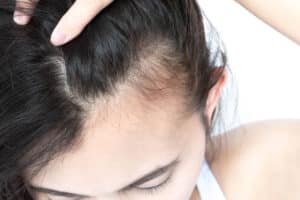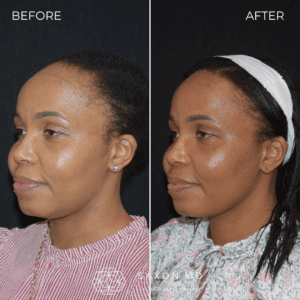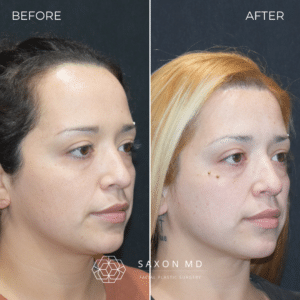Receding Hairline in Women: What Causes It and How to Treat It
If you’re concerned about a receding hairline, you’re not alone. It can be frustrating, especially for women, since we’re not typically expected to experience hair loss in the same way men do. But a receding hairline in women is more common than you might think. In this post, I’ll explain some of the most common causes of a receding hairline in women and what you can do about it.
What Causes a Receding Hairline in Women?
A receding hairline is when the hair along your forehead thins, and the hairline starts to move back. For women, this doesn’t happen naturally as we age, but there are a few conditions that can lead to it. Identifying the cause is important because it helps in finding the right treatment. Let’s go over the main reasons women experience a receding hairline.
1. Traction Alopecia: Tight Hairstyles
Traction alopecia is a common cause of a receding hairline in women. It happens when your hair is pulled too tight for long periods. Tight ponytails, braids, or extensions can put a strain on your hair follicles, leading to hair breakage or even permanent hair loss. If you’ve been wearing your hair this way for years, it can cause the hairline to recede, especially at the temples.
How to Treat It:
The first step is to stop wearing tight hairstyles. You’ll need to switch to looser styles to avoid further damage. If the hair loss is caught early, it’s usually reversible. Hair will often grow back once the tension is removed. If your hairline has already receded significantly, a hair transplant or hairline lowering surgery might be necessary.

2. Menopause and Hormonal Changes
As women approach menopause, their hormone levels, especially estrogen, start to decrease. This change can affect hair growth and lead to thinning, especially at the hairline. In fact, many women notice thinning around the forehead or along their part line.
How to Treat It:
If your hair loss is due to hormonal changes, minoxidil (a topical solution) can help encourage hair growth. Hormone therapy may also help some women, but it’s important to speak with your doctor first.
In some cases, medications like spironolactone or finasteride can help manage hair loss by blocking male hormones like DHT, which can thin hair. PRF therapy is another option that uses your blood’s platelets to stimulate hair follicles and encourage growth.
3. Genetics and Androgenic Alopecia (Female-Pattern Hair Loss)
Genetics plays a big role in female hair loss. If your family has a history of hair thinning, you might be more likely to experience it too. Androgenic alopecia, or female-pattern hair loss, is the most common cause of hair thinning in women. This type of hair loss usually starts with thinning at the part line or crown of the head but can also cause the hairline to recede over time.
How to Treat It:
The first step in treating this type of hair loss is minoxidil. It can help regrow hair and prevent further thinning. If minoxidil alone doesn’t work, medications like spironolactone or finasteride might be used. In more severe cases, hair transplants can help restore the hairline.

4. Exogenous Testosterone Use
Testosterone, when used as part of hormone replacement therapy or for bodybuilding, can cause a receding hairline. If you’re using testosterone for medical reasons or as part of gender-affirming care, you may notice thinning around the hairline, similar to male-pattern hair loss.
How to Treat It:
If you’re using testosterone and notice hair loss, speak with your doctor about managing the side effects. Minoxidil can be used to regrow hair, and finasteride might help prevent further hair thinning. If the hair loss is severe, hair restoration surgery can be a long-term solution.
5. Nutritional Deficiencies
Your diet plays a big role in the health of your hair. If you’re not getting enough vitamins or minerals, it can affect hair growth and lead to thinning hair, including at the hairline. Iron deficiency and vitamin D deficiency are two common causes of hair thinning in women.
How to Treat It:
If a nutritional deficiency is causing your hair loss, you can often fix it by taking supplements or changing your diet. For example, increasing your intake of iron, vitamin D, or biotin can help restore healthy hair growth. If you have a deficiency, your doctor might recommend supplements to correct it. Supplements like Nutrafol, Viviscal, and Xtresse are also popular for supporting healthy hair growth by improving hair density and strength.
6. Frontal Fibrosing Alopecia (FFA)
Frontal fibrosing alopecia is a type of autoimmune hair loss that causes the hairline to recede. It’s more common in postmenopausal women and can also affect the eyebrows. The condition causes permanent scarring of the hair follicles, meaning hair will not regrow in the affected areas.
How to Treat It:
FFA requires medical treatment to slow the progression. This typically includes steroid injections or oral medications like hydroxychloroquine or finasteride to reduce inflammation and stop hair loss. If the condition is caught early, treatments can prevent further hairline recession. In some cases, a hair transplant might be an option once the disease is stable.

7. Stress or Illness (Telogen Effluvium)
Stress or a serious illness can cause a condition called telogen effluvium, where your hair sheds in large amounts. While this type of hair loss doesn’t usually cause a permanent receding hairline, it can cause your hair to thin, especially at the temples or along the forehead.
How to Treat It:
The best way to treat stress-induced hair loss is to reduce stress. Once the stress is under control, your hair should start to regrow within a few months. If the hair loss is caused by an illness, treating the underlying health condition should help restore hair growth.

8. Rapid Weight Loss
Rapid weight loss can also cause a receding hairline. This is increasingly more common with GLP-1 medications like semaglutide and tirzepatide, which promote rapid weight loss. The stress that sudden weight loss puts on your body can trigger telogen effluvium, causing significant hair shedding. This can also happen with eating disorders where rapid or extreme weight loss occurs.
How to Treat It:
If you’ve lost a significant amount of weight quickly, whether from medication or an eating disorder, it’s important to allow your body time to recover. Hair loss from rapid weight loss is usually temporary, and hair should begin to regrow as your body stabilizes and your nutritional levels improve. However, it’s important to work with your healthcare provider to ensure that your nutritional needs are met. Minoxidil can be used to help regrow hair, and improving your diet and managing stress can also support the recovery of healthy hair growth.
How to Restore Your Hairline
If you’re dealing with a receding hairline, it’s important to take action. Depending on the cause of your hair loss, there are several treatment options available:
Minoxidil: This topical solution is the go-to treatment for many women with hair loss. It stimulates hair growth and can help slow down or reverse a receding hairline.
Medications: If hormonal changes or genetics are the cause, medications like spironolactone or finasteride can help block the hormones that cause hair loss.
Hair Transplants: For more advanced cases, hair restoration surgery can help restore a receding hairline by transplanting healthy follicles to the thinning areas.
PRF Therapy: This therapy uses your own blood to stimulate hair follicles and promote hair growth.
Lifestyle Changes: Improving your diet, reducing stress, and avoiding tight hairstyles can all help prevent further hair loss and improve the health of your hair.
Hairline Lowering Surgery: For women who have a naturally high forehead or a receding hairline due to genetic factors, hairline lowering surgery can help by moving the hairline forward. This option is only recommended once the cause of active hair loss is identified and treated. The hairline must be stable before undergoing surgery to ensure the results last.
Supplements: Taking supplements like Nutrafol, Viviscal, or Xtress can help support hair health. These supplements are formulated to improve hair strength and density, especially when combined with other treatments for hair loss.
Managing Rapid Weight Loss: If rapid weight loss is the cause, the best course of action is to stabilize your weight and nutrition. Minoxidil can help with regrowth, but addressing the underlying cause (whether medication-related or from an eating disorder) is key to regaining healthy hair.
Correct a Receding With Hairline Lowering Surgery
For women who have a naturally high forehead or have experienced a receding hairline over time, hairline lowering surgery can be a life-changing solution. This procedure involves surgically advancing the hairline by removing a strip of skin from the forehead and pulling the scalp downward.

The result is a lower, more balanced hairline that can dramatically improve facial proportions and restore confidence. Hairline lowering surgery is best for women whose hair loss has stabilized, as it’s important to address active hair loss before undergoing surgery. Once the cause of hair loss is managed and the hairline is stable, this procedure can provide permanent, natural-looking results.

When to See a Physician at Saxon MD
If you’re noticing a receding hairline or significant hair loss, it’s a good idea to see a hair restoration specialist. They can help determine the cause of your hair loss and recommend the best treatment options for you. Early intervention is key to stopping hair loss and promoting hair regrowth.
If you’d like to learn more about hair restoration or schedule a consultation, contact us at Saxon MD. We’re here to help you find the solution that works for you.
You May Also Like:
- Hairline Lowering vs Hair Grafts: Understanding Your Options for a Better Hairline
- Stem Cell Hair Treatment: A Revolutionary Solution for Hair Restoration
- Understanding Shock Hair Loss: 6 Causes, Recovery and Management
- 6 Effective Ways to Combat and Prevent Traction Alopecia
- Hairline Lowering Before and After Photos